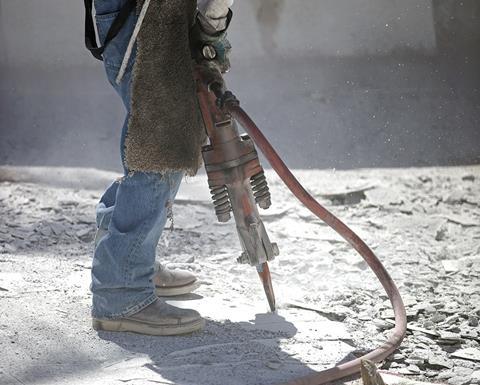Around five million workers are exposed to hand arm vibration. So what can employers do to minimise the risk of this problem and guard against costly insurance claims?

The Health and Safety Executive (HSE) estimates that five million workers are exposed to hand arm vibration (HAV) in the UK with two million exposed to levels where there is a clear risk of developing vibration-related health conditions. Businesses involved in the building sector are among the industries most likely to encounter HAV exposures. So employers should take action to address vibration exposures where employees regularly use hand held or hand guided tools such as breakers, concrete pokers, sanders, grinders, scabblers, disc cutters and hammer drills.
Controlling the risk
Regulations require employers to assess their employees’ exposure to HAVS and, where necessary, introduce control measures to reduce vibration exposure and to provide information, training and health surveillance.
Risk assessments should include observation of working practices, reference to vibration information and, if necessary, measurement of employees’ vibration exposure. This will help to determine whether the exposure is likely to exceed the regulated levels. Control of vibration should be based on eliminating exposure at source or reducing it to the lowest reasonably practicable level. The first approach should always be to remove or avoid exposure to vibration by tackling work in a different way,
or by using more efficient or better designed equipment.
It is important that vibration risk assessments are carried out by someone who understands the work employees undertake
Management controls such as equipment maintenance, provision of training and information, control of exposure time and rest periods and the provision of clothing to protect employees from cold and damp can help reduce the risk still further.
Record keeping
It is important that vibration risk assessments are carried out by someone who understands the work employees undertake and the requirements of the regulations.
The assessment should be recorded and address working conditions and processes, probable exposures and, if necessary, specific exposure measurement. In the event of a specific exposure measurement, it is essential that the equipment is measured performing the task in its usual conditions, for example on the same kind of material in order to ensure accurate measurements are taken.

As with any risk assessment process, it is important to carry out regular reviews and to challenge assessments in the light of any instances of ill health, evidence of control failures or equipment or work changes.
Controlling the workplace
Consideration of the effects of vibration exposure on employees whose health is at risk is a fundamental part of the risk assessment process. Health surveillance forms an important checking process to ensure control measures remain effective. However, working within the HSE guidelines will not necessarily provide a defence to a claim.
The age of the claimant is another significant factor. The younger the claimant, the longer their future career could be subject to a disadvantage
If it is reasonably practicable to reduce exposure further then this is what the regulations require. Health surveillance to diagnose or prevent health effects linked to vibration exposure at work is required where the risk assessment identifies that there is a risk to employees’ health from vibration or that exposure is likely to exceed the exposure action value.
Recording preventative steps taken
To maximise the defence of claims it is recommended that a programme of preventative measures is undertaken and recorded for all employees making use of vibratory tools.
These records should be retained and be accessible in the future. Failing to address the fundamental issues of assessment, control and health surveillance also renders employers open to criminal enforcement action and a conviction following prosecution will undermine any defence to a subsequent civil claim.
Impact on future employment
Uncontrolled exposure is also likely to exacerbate the severity of the damage suffered and the value of the claim.
HAV claims also often include an element of disadvantage on the open labour market, if a person can no longer make use of vibratory tools, has reduced dexterity or is restricted from working in cold conditions.
The age of the claimant is another significant factor. The younger the claimant, the longer their future career could be subject to a disadvantage, while for older claimants there is more likely to be a limited skill set and less scope for finding future employment. Either way, failure to control vibration risks could prove expensive.
Financial benefits of managing risks
Proactive prevention of vibration injury can provide significant financial benefits by avoiding the following issues:
- It is costly to adjust work tasks, comply with Disability Discrimination Act requirements and manage the termination of employment
- Claims can be expensive when somebody becomes restricted in relation to their future employment. Also, assessing or making adjustments for employees who can no longer make use of any tools takes up considerable management time.
- Effective risk management means claims can be better controlled, which impacts on the employer’s and insurer’s bottom line.
Savings can be made if you:
- Reduce exposure
- Gain control of vibration levels
- Minimise the number of employees that become symptomatic, so any symptoms within your workforce remain at a manageable level.
Simon Taylor is executive director at specialist broker Clear Insurance



























No comments yet